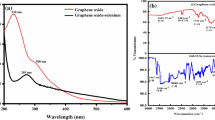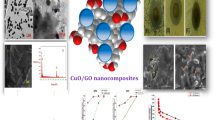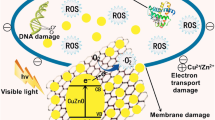Abstract
We report the synthesis of tungsten trioxide (WO3) nanoparticles and its nanocomposite with graphene oxide (GO) by cost-effective and high yield hydrothermal method. The structural pattern and morphology of produced nanoparticles are studied through X-ray diffraction (XRD) and scanning electron microscopy (SEM) respectively. XRD pattern confirms the presence of nanocrystalline hexagonal phase of WO3. SEM results show well-defined rectangular nanorods of WO3, and the GO is in layered structure that has homogeneous and ultra-thin films of graphene. In WO3/GO nanocomposite, the GO sheets are sublimely mixed with WO3 nanoparticles and have changed the morphology of WO3. Furthermore, the diffuse reflectance spectroscopy (DRS) and Fourier transform infrared spectroscopy (FTIR) are performed. The reduction in bandgap of WO3 by the incorporation of GO is observed by DRS that can improve the visible light harvesting rate of WO3. The transmittance peaks of WO3 and the bond of W and C in the nanocomposite are observed in FTIR spectra. Antimicrobial activity of WO3, GO, and WO3/GO nanocomposite by using three different strains (E.coli, Pseudomonas aeruginosa and Candida albicans) is examined. The obtained results demonstrate potential application of WO3, GO, and WO3/GO nanocomposite as antimicrobial agent.












Similar content being viewed by others
References
D. Zappa, A. Bertuna, E. Comini, N. Kaur, N. Poli, V. Sberveglieri, and G. Sberveglieri (2017). Metal oxide nanostructures: preparation, characterization and functional applications as chemical sensors. Beilstein J Nanotechnol. 8, 1205–1217.
T. M. Salama, M. Morsy, R. M. A. Shahba, S. H. Mohamed, and M. M. Mohamed (2019). Synthesis of graphene oxide interspersed in hexagonal WO3 nanorods for high-efficiency visible-light driven photocatalysis and NH3 gas sensing. Front. Chem. 7, 1–14.
V. R. Buch, A. K. Chawla, and S. K. Rawal (2016). Review on electrochromic property for WO3 thin films using different deposition techniques. Materials Today: Proceeding 3, 1429–1437.
M. Mostafa, S. A. Yousef, W. H. Eisa, M. A. Ewaida, and E. A. Al-Ashkar (2019). WO3 quantum dot: synthesis, characterization and catalytic activity. J. Mol. Struct. 1185, 351–356.
H. Elbohy, K. M. Reza, S. A. Karim, and Q. Qiao (2018). Creation of oxygen vacancies to activate WO3 for higher efficiency dye-sensitized solar cells. Sustain. Energy Fuels 2, 403–412.
X. Liu, H. Zhai, P. Wang, Q. Zhang, Z. Wang, Y. Liu, Y. Dai, B. Huang, X. Qin, and X. Zhang (2019). Synthesis of a WO3 photocatalyst with high photocatalytic activity and stability using synergetic internal Fe3+ doping and superficial Pt loading for ethylene degradation under visible-light irradiation. Catal. Sci. Technol. 9, 652–658.
J. Su, L. Guo, N. Bao, and C. A. Grimes (2011). Nanostructured WO3/BiVO4heterojunction films for efficient photoelectrochemical water splitting. Nano Lett. 11, 1928–1933.
Q. Chen, J. Li, X. Li, K. Huang, B. Zhou, W. Cai, and W. Shangguan (2012). Visible-light responsive photocatalytic fuel cell based on WO3/W photoanode and Cu2O/Cu photocathode for simultaneous wastewater treatment and electricity generation. Environ. Sci. Technol. 46, 11451–11458.
X. Chen, Y. Zhou, Q. Liu, Zh. Li, J. Liu, and Zh. Zou (2012). Ultrathin, single-crystal WO3nanosheets by two-dimensional oriented attachment toward enhanced photocatalystic reduction of CO2 into hydrocarbon fuels under visible light. ACS Appl. Mater. Interfaces 4, 3372–3377.
P. Wang, B. Huang, X. Qin, X. Zhang, Y. Dai, and M. H. Whangbo (2009). Ag/AgBr/WO3 •H2O: visible-light photocatalyst for bacteria destruction. Inorg. Chem. 48, 10697–10702.
G. Duan, L. Chen, Z. Jing, P. D. Luna, L. Wen, L. Zhang, L. Zhao, J. Xu, Z. Li, Z. Yang, and R. Zhou (2019). Robust antibacterial activity of tungsten oxide (WO3-x) nanodots. Chem. Res. Toxicol. 32, 1357–1366.
S. Sonia, P. S. Kumar, D. Mangalaraj, N. Ponpandiana, and C. Viswanathan (2013). Influence of growth and photocatalytic properties of copper selenide (CuSe) nanoparticles using reflux condensation method. Appl. Surf. Sci. 283, 802–807.
F. Deng, X. Pei, Y. Luo, X. Luo, D. D. Dionysiou, S. Wu, and S. Luo (2016). Fabrication of hierarchically porous reduced graphene oxide/ SnIn4S8 composites by a low-temperature co-precipitation strategy and their excellent visible-light photocatalytic mineralization performance. Catalysts 6, 113–119.
S. Sajjad, M. Khan, S. A. K. Leghari, N. A. Ryma, and S. A. Farooqi (2018). Potential visible WO3/GO composite photocatalyst. Int. J. Appl. Ceram. Technol. 16, 1–10.
P. Kumar, P. Huo, R. Zhang, and B. Liu (2019). Antibacterial properties of graphene-based nanomaterials. Nanomaterials 9, 737.
T. A. Saleh and V. K. Gupta (2011). Functionalization of tungsten oxide into MWCNT and its application for sunlight-induced degradation of rhodamine B. J. Colloid Interface Sci. 362, 337–344.
W. Hu, C. Peng, W. Luo, M. Lv, X. Li, D. Li, Q. Huang, and C. Fan (2010). Graphene-based antibacterial paper. ACS Nano 4, 4317–4323.
M. Muniyalakshmi, K. Sethuraman, and D. Silambarasan (2020). Synthesis and characterization of graphene oxide nanosheets. Materials Today: Proceedings 21, 408–410.
S. Pei and H.-M. Cheng (2012). The reduction of graphene oxide. Carbon 50, 3210–3228.
A. Bagri, C. Mattevi, M. Acik, Y. J. Chabal, M. Chhowalla, and V. B. Shenoy (2010). Structural evolution during the reduction of chemically derived graphene oxide. Nat. Chem. 2, 581–587.
X. Li, F. Li, Z. Gao, and L. Fang (2015). Toxicology of graphene oxide nanosheets against paecilomyces catenlannulatus. Bull. Environ. Contam. Toxicol. 95, 25–30.
X. Wang, X. Liu, and H. Han (2013). Evaluation of antibacterial effects of carbon nanomaterials against copper-resistant Ralstonia solanacearum. Colloids Surf. B Biointerfaces 103, 136–142.
S. Jayanthi, N. K. Eswar, S. A. Singh, K. Chatterjee, G. Madras, and A. Sood (2016). Macroporous three-dimensional graphene oxide foams for dye adsorption and antibacterial applications. RSC Adv. 6, 1231–1242.
S. R. V. Castrillón, F. O. Perreault, A. F. D. Faria, and M. Elimelech (2015). Interaction of graphene oxide with bacterial cell membranes: Insights from force spectroscopy. Environ. Sci. Technol. Lett. 2, 112–117.
J. Zhao, Z. Wang, J. C. White, and B. Xing (2014). Graphene in the aquatic environment: Adsorption, dispersion, toxicity and transformation. Environ. Sci. Technol. 48, 9995–10009.
M. S. Khan, H. N. Abdelhamid, and H. F. Wu (2015). Near infrared (NIR) laser mediated surface activation of graphene oxide nanoflakes for effcient antibacterial, antifungal and wound healing treatment. Colloids Surf. B Bio interfaces 127, 281–291.
I. Sengupta, P. Bhattacharya, M. Talukdar, S. Neogi, S. K. Pal, and S. Chakraborty (2019). Bactericidal effect of grapheme oxide and reduced graphene oxide: Influence of shape of bacteria. Colloid Interface Sci. Commun 28, 60–68.
T. N. Kovács, I. E. Lukács, A. Szabó, K. Hernadi, T. Igricz, K. László, I. M. Szilágyi, and G. Pokol (2020). Effect of pH in the hydrothermal preparation of monoclinic tungsten oxide. J. Solid State Chem 281, 121044.
A. L. Patterson (1939). The scherrer formula for X-ray particle size determination. Phys. Rev. 56, 978–982.
P. Kubelka and F. Munk (1931). A contribution to the optics of pigments. Z. Tech. Phys. 12, 593–601.
R. S. Vemuri, M. H. Engelhard, and C. V. Ramana (2012). Correlation between surface chemistry, density, and band gap in nanocrystalline WO3 thin films. ACS Appl. Mater. Interfaces 4, 1371–1377.
I. Ahmad, M. Usman, T.-K. Zhao, S. Qayum, I. Mahmood, A. Mahmood, A. Diallo, C. Obayi, F. I. Ezema, and M. Maaza (2020). Bandgap engineering of TiO2 nanoparticles through MeV Cu ions irradiation. Arab. J. Chem. 13, 3344.
K.-ul Haq, M. Usman, T. Iqbal, R. Y. Khosa, I. Ahmad, J. Luo, and T.-K. Zhao (2021). Carbon ion irradiation induced structural, optical and electrical effects in TiO2 nanoparticles. Radiat. Phys. Chem. 180, 109297.
L. Gan, L. Xu, S. Shang, X. Zhou, and L. Meng (2016). Visible light induced methylene blue dye degradation photo-catalyzed by WO3/grapheme nanocomposites and the mechanism. Ceramics International 42, 15235–15241.
V. B. Kumar and D. Mohanta (2011). Formation of nanoscale tungsten oxide structures and colouration characteristics. Bull. Mater. Sci. 34, 435–442.
T. Thilagavathi, D. Venugopal, and E. Gobichettipalayam (2018). Synthesis and characterization of WO3 nanoparticles for photocatalytic degradation of methylene blue dye. Int. J. Res. Eng. Appl. Manag. 4, 317–320.
K. Kalantar-zadeh, A. Vijayaraghavan, M. H. Ham, H. Zheng, M. Breedon, and M. S. Strano (2010). Synthesis of atomically thin WO3 sheets from hydrated tungsten trioxide. Chem. Mater. 22, 5660–5666.
G. Jeevitha, R. Abhinayaa, D. Mangalaraj, and N. Ponpandian (2018). Tungsten oxide-graphene oxide (WO3-GO) nanocomposite as an efficient photocatalyst, antibacterial and anticancer agent. J. Phys. Chem. Solids 116, 137–147.
Y. L. Ying, S. Y. Pung, S. Sreekantan, Y. F. Yee, M. T. Ong, and Y. F. Pung (2019). Structural and antibacterial properties of WO3/ZnO hybridparticles against pathogenic bacteria. Materials Today: Proceedings 17, 1008–1017.
S. L. Lima, A. L. Colombo, and J. N. A. Junior (2019). Fungal cell wall: emerging antifungals and drug resistance. Front. Microbiol. 10, 2573.
S. Ganguly, P. Das, M. Bose, T. K. Das, S. Mondal, A. K. Das, and N. C. Das (2017). Sonochemical green reduction to prepare Ag nanoparticles decorated graphene sheets for catalytic performance and antibacterial application. Ultrason. Sonochem. 39, 577–588.
Author information
Authors and Affiliations
Corresponding authors
Additional information
Publisher's Note
Springer Nature remains neutral with regard to jurisdictional claims in published maps and institutional affiliations.
Rights and permissions
About this article
Cite this article
Muzaffar, T., Khosa, R.Y., Iftikhar, U. et al. Synthesis and Characterization of WO3/GO Nanocomposites for Antimicrobial Properties. J Clust Sci 33, 1987–1996 (2022). https://doi.org/10.1007/s10876-021-02116-2
Received:
Accepted:
Published:
Issue Date:
DOI: https://doi.org/10.1007/s10876-021-02116-2




